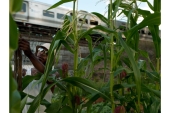I live near a couple different nature preserves. In these preserves, they have the California red-legged frog, which is threatened (primarily in the Sierra Nevadas - they're quite plentiful by the coast).
I have a bucket on my deck that I use to collect rainwater, which I can then use to water plants. It's been sitting out there for quite some time. One day, I looked in the bucket, and I saw that there are a bunch of tadpoles in it! I've heard frogs out there at night, I guess they made good use of the water. Everything's been rather dry out here since all the rain comes in a few big events rather than consistently.
Youtube has made changes recently that seem to have broken embedding videos below a certain length on Permies. You can view a video of the tadpoles as I first discovered them here:
https://www.youtube.com/shorts/HyJVLMlf8TI
They seemed a bit stressed in the bucket with a dwindling supply of water and zero cover. I added some pinecones, sticks, and green fodder to the bucket to make more of a habitat for them. I also added a bunch of water, although I made sure to let it sit first to allow the chlorine and fluoride to evaporate from it. City water!
I've been checking on them every day and they seem to be fine. Now that I added places for them to hide they are harder to spot, but when my shadow passes over the bucket that freaks them out and lets me see them.
Based on my research it takes ~7 months for them to become frogs. They also are expected to go dormant during the summer due to lack of water, but I'm not sure how that will work in a bucket. Furthermore, I know that my bucket will be an increasingly accessed water source by birds as the summer goes on and the puddles and wallows dry up. Once they reach adulthood they can hop out to the forest with the next rainfall, but until then I'm just checking on them once a day and adding water if needed.









